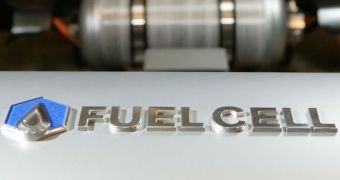If you are still waiting for the hydrogen powered electric cars, then this info should really make your day. The two problems related to the mass production of fuel cells, the efficiency of extracting electric energy and the relatively high cost of such cells, could be both resolved with the invention of a new material that acts as a proton exchange membrane inside the fuel cell.
The proton exchange membrane represents a key component in a fuel cell, as it enables electric energy to be gathered during the chemical reaction that binds hydrogen gas to oxygen, which results in the creation of water. The basic reaction that takes place in the membrane involves striping electrons from the hydrogen atoms and collecting them in the form of electrical energy, combining the hydrogen to oxygen in the process. The reverse process is well known and studied during chemistry classes in school, and involves pumping electric energy through water, which determines the chemical bonds between hydrogen and oxygen to break.
The newly designed material, has been developed by Klaus Schmidt-Rohn and Qiang Chen from the Ames Laboratory, and consists of a perfluorinated polymer that presents permeability to water and protons. The Nafion material presents a nanoscale structure made of cylindrical channels, on a film about a few tens of microns thick, just enough to let water and protons pass directly through it. The 2.5 nanometer cylinders present special affinity towards water, thus even though the structure is not perfectly aligned they still connect to create water passing medium through the material.
In order to determine the basic mechanism of how the material works, Schmidt-Rohr made several calculations to show that Nafion uses densely packed channels through the structure through which water could pass. However, certain mathematical models seemed to be unable to explain the scattering curves observed while studying the material characteristics with the X-ray and neutron imaging techniques.
Nevertheless, this material was able to give crucial insight on the phenomenon that takes place during the conductivity of water frozen to temperatures well below zero degrees Celsius. Schmidt-Rohr explains that as water freezes it creates large channels, similar to those observed in the Nafion material, which connect and provide a path through which water would continue to diffuse. However, the process that triggers the connection of the cylinders in the nanostructure remains elusive and needs detailed study.

 14 DAY TRIAL //
14 DAY TRIAL //